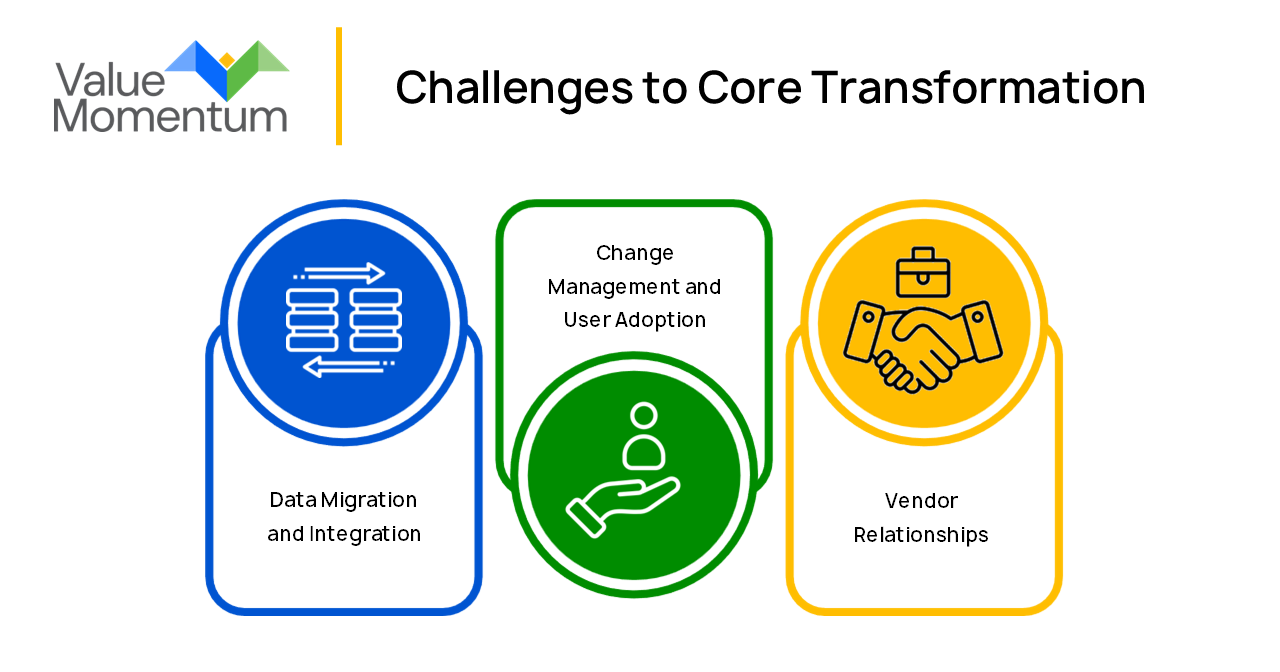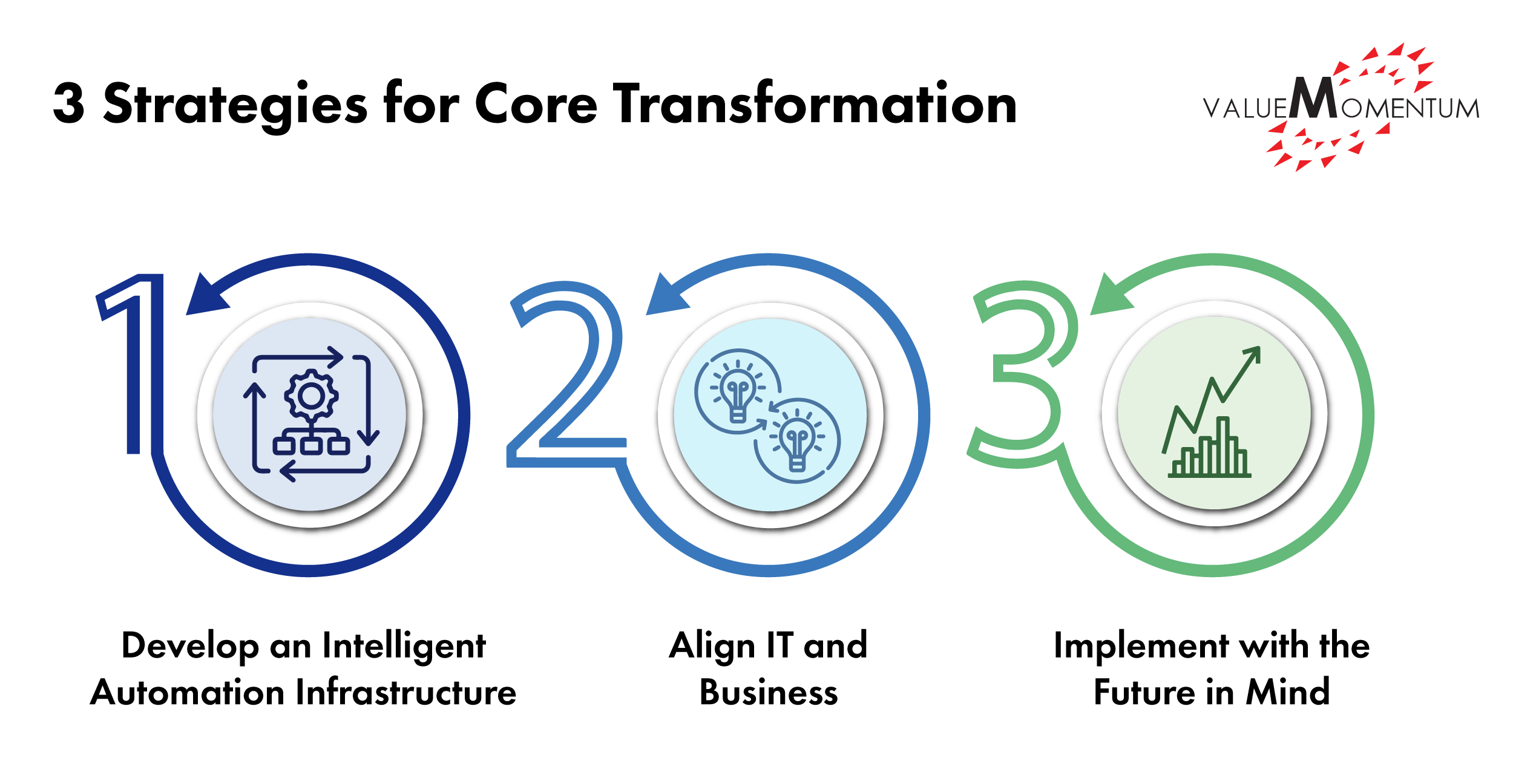In an era marked by unprecedented technological advancements, insurers are migrating toward cloud-based core suites for greater efficiency and scalability and leaving behind traditional legacy systems. This paradigm shift brings with it a host of benefits, including enhanced customer experience, streamlined insurance operations, and opportunities for market expansion. As expected, core transformation is the top IT priority for both midsize and large insurers in 2023, according to analyst firm Datos, formerly Aite-Novarica.
A new core implementation, however, is a laborious and complex journey. Without an intentional and well-planned roadmap, insurers can end up with increased maintenance costs, underutilized functionalities, and more technology debt. In this blog, we delve into some critical challenges insurers need to consider in order to achieve a successful cloud-based core transformation.
Challenges to Core Transformation
Core transformation challenges can be broken down into three areas:
- Data migration and integration
- Change management and adoption
- Vendor relationships

But the transition to a cloud-based suite of core systems brings its own set of pain points, including new security concerns and a migration of messy, unstructured historical data to the cloud. Insurers often make the mistake of focusing solely on technological implementation, but a successful core transformation will need both the right technical infrastructure and an enterprise-wide shift across talent, IT and business alignment, and partnerships.
- Data Migration and Integration
Legacy systems pose a formidable technical challenge for insurers during the core transformation process due to their inherent complexities and a large amount of historical data. Developed over a period of years with multiple layers of technology, these systems lack the agility and scalability needed for seamless integration into modern cloud environments. Migrating unstructured data and functionalities from these systems to the cloud commonly leads to compatibility issues, data corruption, and operational bottlenecks. Insurers also fear the exposure of sensitive customer and business information to breaches, as cloud-based core suites can be more vulnerable than on-premises systems if not properly secured and administered.
- Change Management and User Adoption
Complex core system replacements touch all parts of insurers’ organizations, and their lengthy duration invites changing business outcomes and requirements. This means traditional project parameters no longer suffice in terms of the continuous engagement and quality testing needed to introduce products on a cloud-based core. As a new core implementation can take years to complete, insurers may also face high turnover between projects while necessarily cultivating new skill sets to manage the core suite. Without an iterative, agile change-management process in place during the insurer’s cloud migration journey, managing the in-transition state between an on-premises and cloud-based core will incur more technology debt and hefty implementation costs.
- Vendor Relationships
For many insurers, core transformation will involve a partnership with platform vendors that provide a core suite. Each platform offers unique strengths and capabilities tailored to specific insurance niches across billing, policy, claims processing, etc. While this provides insurers with a diversity of choices, it also necessitates a deep understanding of insurers’ own operational needs and growth goals, as well as a precise plan for implementation and continued maintenance. As there is no one-size-fits-all solution in the realm of cloud-based core transformation, insurers may experience misalignments of expectations and expertise without a strategic partner that accommodates ongoing support, application management, and platform modernization.
Strategies for Core Transformation
These challenges illuminate a key fact: core transformation is both a technological and business evolution. To drive the growth advantages that a cloud-based core can provide, insurers must marry a sound business strategy and technical foundation to support a self-sufficient core. Here are some strategies to address core transformation challenges:

- Develop an Intelligent Automation Infrastructure
Developing an intelligent automation infrastructure is critical to successfully tackling the challenge of data migration and integration. This involves leveraging AI/ML tools and technologies to streamline the process of migrating data from legacy systems to the new cloud-based core suite. By automating data mapping, transformation, and validation, insurers can reduce the risk of data corruption and compatibility issues. Furthermore, automation can help in cleaning and structuring historical data before migration, ensuring that it aligns with the new system’s requirements.Intelligent automation also extends to ongoing data synchronization between the old and new systems during the transition phase. This ensures that the business operations continue smoothly and without disruption. Moreover, automation can be employed to monitor data flows, identify anomalies, and trigger alerts for timely intervention. By implementing an intelligent automation infrastructure, insurers can enhance data accuracy, minimize migration-related risks, and accelerate the core transformation process.
- Align IT and Business
To address the challenge of change management and user adoption, insurers must gradually shift metrics and team organizations from project to product. This involves upskilling cross-functional teams and changing metrics from solely measuring the success of technical functionalities to focusing on tangible business outcomes. Ensuring that IT teams understand the strategic goals of the business and can communicate the benefits of the new core system to other departments is crucial.Implementing an iterative, agile change management process will make the transition smoother. Regular communication, training sessions, and involving end-users in the decision-making process can help build buy-in and reduce resistance. By emphasizing how the new core system aligns with the insurer’s broader business objectives and improves efficiency and customer service, the organization can foster a positive attitude toward the change enterprise wide. - Implement with the Future in Mind
Insurers should approach core transformation as a continuous journey rather than a one-time project. Addressing this challenge requires insurers to recognize that core transformation, especially in the cloud, does not end with the initial implementation. The new system must be flexible and adaptable to accommodate future upgrades, new business initiatives, and regulatory changes.Choosing a partner with deep insurance expertise is vital. This partner can assist not only with the initial implementation but also with ongoing application management, upgrades, and modernization. A strategic partner can help insurers stay up to date with industry trends, regulatory changes, and emerging technologies, ensuring that the core system remains aligned with the insurer’s long-term goals.
Driving Sustainable Core Success
In the fast-evolving landscape of the insurance industry, cloud-based core transformation has become an imperative for insurers aiming to enhance customer experiences and operational efficiencies. However, the journey is riddled with challenges related to data migration, change management, and vendor relationships. To successfully navigate these challenges, insurers must adopt a multi-pronged approach.
Developing an intelligent automation infrastructure streamlines data migration and integration, reducing the risks associated with legacy systems. On top of the right technology and tools, insurers must align IT and business functions to ensure that the new core system directly applies to their growth business goals. Lastly, implementing with the future in mind, coupled with a strategic partner, guarantees the longevity of the core system’s effectiveness and relevance.
Ready to embark on your cloud-based core transformation journey? Check out our CoreLeverage Team for more information.

